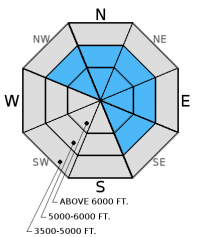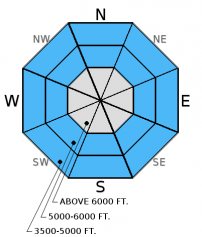| Thursday | Thursday Night | Friday | |
|---|---|---|---|
| Cloud Cover: | Snow and increasing wind. | Another shot of snow into tomorrow. Sustained winds. | A brief lull in precipitation during the day. |
| Temperatures: | 33 to 44 deg. F. | 23 to 30 deg. F. | 31 t o42 deg. F. |
| Wind Direction: | Southwest | Southwest | Southwest |
| Wind Speed: | 14-16 mph with gusts to 40 mph. | 20-30 mph with gusts to 52 | 10-20 mph with gusts to 40 mph. |
| Snowfall: | 0-4 in. | 1-3 in. | 0-1 in. |
| Snow Line: |
Whitefish Range
Swan Range
Flathead Range and Glacier National Park
How to read the forecast
New snow today combined with increasing winds will likely form fresh wind slabs above 5000 feet and create heightened avalanche conditions. Human triggered avalanches are possible and could become likely. Weak layers 2-4 feet from the surface still exist and require careful snow and terrain evaluation. The danger will begin MODERATE and could rise to CONSIDERABLE on wind loaded terrain by this afternoon. See discussion below.

2. Moderate
?
Above 6500 ft.
2. Moderate
?
5000-6500 ft.
2. Moderate
?
3500-5000 ft.
- 1. Low
- 2. Moderate
- 3. Considerable
- 4. High
- 5. Extreme
-
Type ?
-
Aspect/Elevation ?

-
Likelihood ?CertainVery LikelyLikelyPossible
 Unlikely
Unlikely -
Size ?HistoricVery LargeLargeSmall

Today's new snow and expected strong winds will form wind slabs at mid and upper elevations. I expect wind slabs to become more sensitive and thicker as the day progresses. These fresh wind slabs will add depth to lingering wind slabs from the past three days. These older wind slabs formed on a rain crust from 2/14. This rain crust extends to over 7000 feet in many locations throughout our advisory area and could provide a great sliding surface for avalanches. In isolated areas these fresh wind slabs may sit on top of surface hoar formed last week, particularly on slopes facing the north half of the compass. Look for rounded pillows of wind drifted snow on leeward sides of ridges and cross-loaded areas in gullies at both mid and upper elevations, and carefully evaluate all wind loaded terrain.
-
Type ?
-
Aspect/Elevation ?

-
Likelihood ?CertainVery LikelyLikelyPossible
 Unlikely
Unlikely -
Size ?HistoricVery LargeLargeSmall

Recent warm temperatures have helped to strengthen the snowpack and minimize this problem. However, buried surface hoar and faceted snow around a variety of crusts from mid and late January about 2-4 feet from the surface still exist. A recent natural slab avalanche observed on Nyack Mountain on Monday in the Flathead Range appears to have released 4 feet deep, but was likely triggered by wind loading. This is a low probability/high consequence scenario that should be treated with respect. A couple of avalanches triggered by cornice fall earlier last week propagated far and wide (photo 1, photo 2). We have few recent observations from the upper elevation alpine regions over the past 3-4 days where this problem is of most concern so extra caution and snowpack evaluation is warranted in these locations.
-
Type ?
-
Aspect/Elevation ?

-
Likelihood ?CertainVery LikelyLikelyPossible
 Unlikely
Unlikely -
Size ?HistoricVery LargeLargeSmall

This should be a short-lived problem at lower and mid-elevations today as rain to turns to snow and warm temperatures drop as a cold front passes through the region. Also, the low elevations experienced a fair bit of rain over the past week and are likely capable of handling the additional load today. Nevertheless, watch for early signs of wet snow instability including rollerballs and pinwheels.
There is some uncertainty with the amount of precipitation the region will receive today. Most models suggest up to 0.5 inches of liquid precipitation and up to 6 inches of snow, but the chance for up to 10 inches by tonight at upper elevations is not out of the question. Given this uncertainty it is important to pay attention to changing conditions today. With winds on the increase as well it will become more likely that you can trigger an avalanche as the day progresses. The avalanche danger could rise to CONSIDERABLE on wind loaded terrain by this afternoon.
Wednesday: Mark and I toured in the Canyon Creek/Skookoleel Creek area where we found previous wind loading, large cornices, and a new rain crust formed in mid-February (observation). BNSF Avalanche Safety reported no new avalanche activity yesterday in John F. Stevens Canyon in southern Glacier Park.
Monday: BNSF Avalanche Safety reported a slab avalanche on Nyack Mountain in the Flathead Range with a crown depth estimated at 3-4 feet deep. Active wind loading was observed at upper elevations. Forest Service snowmobile staff riders rode into the Canyon Creek drainage of the southern Whitefish Range and observed rollerballs, wet loose avalanche activity at mid elevations and wind loading at the ridges. In their snowpit they found a decomposing surface hoar layer 14" below the snow surface (observation).
Sunday: We visited Sub-Shields in the Flathead Range where wind was actively transporting the new snow and forming thin wind slabs and cornices (video). A seperate party of skiers on Sub-Shields noted about 4 inches of new snow on the rain crust and observed minimal results in stability tests (observation). Skiers in the Marion Lake area also in the Flathead Range found a layer 75 cm from the surface that fractured with hard force in Extended Column Tests and produced clean shears (Q1) in shovel shear tests.
Saturday: We were on Hash Mountain in the Swan Range and found the previous night's snow levels were higher than expected. At 7050 feet there was a rain crust with only 1-2 inches of snow on top. 10-15 mph winds were drifting the snow, there just was not much of it. We found the thin late January crust with weak snow around it 2.5 feet from the surface (photo). This layer did not fracture in our stability tests.
Friday: We were in McGinnis Creek in the southern Whitefish Range and found a wet snow surface up to at least 6000 feet. We noted a layer of decomposing buried surface hoar that was 6-10 inches from the surface that fractured in stability tests (observation).
Visit our Observations page and our You Tube channel for more observations from the entire season.
Thanks to everyone for submitting observations. They are extremely useful and could help save lives.
HOW TO SUBMIT OBSERVATIONS:
Email: [email protected]
Call and leave a message: 406.387.3821
You can also submit quick observations via text: 406.241.4571 (FAC mobile)
OR
Submit Snowpack Observations: http://www.flatheadavalanche.org/node/add/snowobs
Submit Avalanche Observations: http://www.flatheadavalanche.org/node/add/avyobs
Yesterday and last night were mostly dry with a bit of precipitation overnight resulting in 0 to 1 inch of new snow. As of 5:00 am, temperatures above 6000 feet range from 31º-36º F, and winds are out of the southwest at 1-9 mph with gusts to 17 mph. Today, we could see 4-6 inches of new snow with potentially 10 inches at the upper most elevations in the Flathead Range and Glacier Park. Temperatures will begin in the low to mid-30s F this morning and drop in the late morning along with snow levels. Expect winds to increase today out of the southwest at 15-25 mph with gusts to 55 mph.
The past 6 days have been relatively active with precipitation (both rain and snow). Most SNOTEL sites across the advisory area around 6000 feet picked up 2.4 to 2.7 inches of snow water equivalent in this period. With rain, snow, and warming temperatures, a myriad of avalanche problems can exist.
| 0600 temperature: | 31 to 36 deg. F. |
| Max. temperature in the last 24 hours: | 31 to 39 deg. F. |
| Average wind direction during the last 24 hours: | Southwest |
| Average wind speed during the last 24 hours: | 1-17 mph |
| Maximum wind gust in the last 24 hours: | 17-25 mph |
| New snowfall in the last 24 hours: | 0 inches |
| Total snow depth: | 71-93 inches |
This advisory applies only to backcountry areas outside established ski area boundaries. This advisory describes general avalanche conditions and local variations always occur. This advisory expires at midnight on the posted day unless otherwise noted. The information in this advisory is provided by the USDA Forest Service who is solely responsible for its content.








































